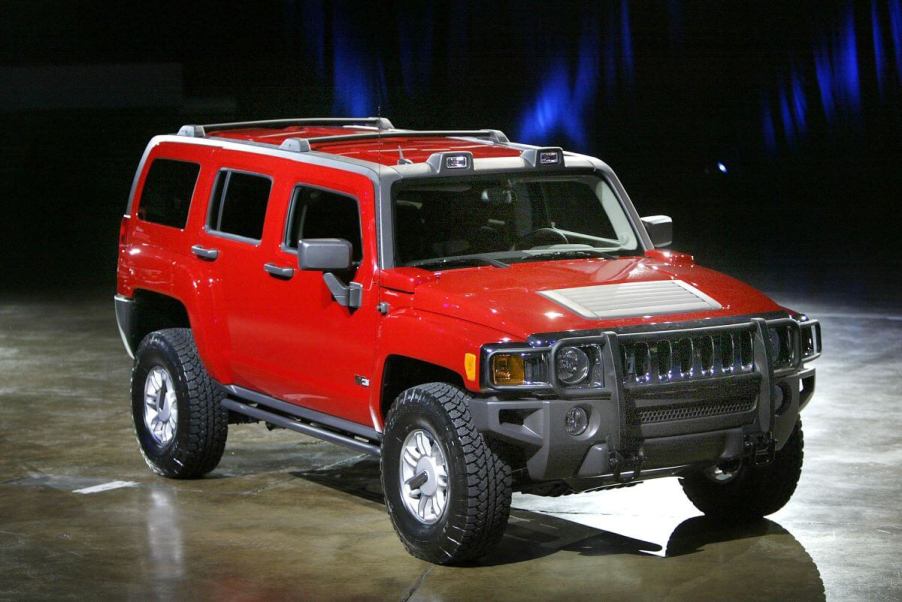
What Hummer Model Has the Best Fuel Economy?
There’s an urban legend that Austrian-American bodybuilder-turned-actor Arnold Schwarzenegger was driving to the set of Kindergarten Cop (It’s not a toomah!) when he saw his first Hummer. Well, technically, it was the military Humvee version, but as the story goes, Schwarzenegger was so smitten that he locked up his vehicle’s brakes and caused an accident just to get a better look.
Exactly true or not, the actor and future governor of California was instrumental in persuading AM General to market a civilian version of their comically huge off-road Humvee, called the Hummer H1. Less than a decade later, General Motors bought the Hummer brand and expanded the lineup to include some smaller — in a relative sense — vehicles like the H2 and H3. Not that many would-be Hummer buyers would care, but did any of them deliver decent fuel economy?
The H1 was definitely the worst for fuel economy
Much has been written about the Hummer H1, a monument to excess, so we’ll skip over the details, like its 16 inches of ground clearance and remote tire inflation system. Although most H1s were diesel-powered, some gasoline versions were made with a 190 horsepower, 5.7-liter small-block Chevy.
While no H1 is considered quick, the gasoline engine was particularly dismal at motivating the off-roader’s near-7,000 pound heft. Its 0 to 60 mph acceleration took 18.1 seconds, according to a Car and Driver test. Fuel economy for the gasser was estimated at 10 mpg around town and 11 mpg on the highway. In real life, the outlet only observed 9 mpg.
In its final year of 2006, the H1 received an Alpha performance package with a 300-hp diesel engine. Its 0 to 60 mph acceleration dropped to a mere 13.5 seconds, and MotorTrend estimated the fuel economy at an improved 11 to 12 mpg. Fortunately, all H1s had a massive 50+ gallon fuel tank, so the range was still decent.
GM introduced smaller Hummers
Upon purchasing the Hummer brand, one of GM’s first moves was to develop the H2, a more reasonably sized off-roader based on a heavy-duty Chevy pickup truck chassis. The H2 was initially available as a traditional wagon-style SUV and later, with an abbreviated pickup truck bed and midgate, called the Sport Utility Truck (SUT).
The H2 retained the classic Hummer’s chunky, rugged styling but in a more practical and comfortable package for everyday use. Like the H1, Hummer was not required to publish official fuel economy ratings for the H2 because the EPA exempted such heavy vehicles from reporting.
Automotive publications at the time discovered fuel economy in the range of 12 to 14 mpg, which was a tiny improvement over its predecessor. At least acceleration and passing power had picked up, with a series of V8 engines producing between 325 and 393 horsepower.
Amid widespread derision and even environmental protesters that vandalized some H2s, Hummer launched the smaller still H3 in 2006, based on the Chevy Colorado midsize pickup. Initially, the H3 shared an inline five-cylinder with the Colorado and was later available with a 5.3-liter V8, making for a sporty driving experience in the relatively compact H3.
While Hummer was on the right track, fuel economy was still fairly poor. The five-cylinder was rated at an EPA-estimated 14 mpg in the city and 18 mpg on the highway, while the V8 got 13/16 mpg, respectively.
Hummer couldn’t climb over a recession
In approximately 2008, two events occurred that hit Hummer hard. The first was the Great Recession due to the burst of the U.S. housing bubble. Consumers were struggling, and an expensive new SUV purchase was outside the realm of many.
At the same time, gas prices soared to $5.10 per gallon, adjusted for inflation — a record that wasn’t broken until 2022. This high fuel cost imposed an exclamation point on the Hummer’s poor fuel economy. General Motors unsuccessfully tried to sell the brand to Chinese investors, but the deal fell through at the last moment. In 2010, GM shut down the Hummer brand, along with Saturn and Pontiac.
A new electrified future for the Hummer
Perhaps it was fortuitous that GM wasn’t able to sell Hummer because the nameplate was revived in 2022. Only this time, the latest Hummer doesn’t burn an ounce of fuel because it’s an all-electric vehicle. The Hummer EV’s size, styling, and off-road chops are as outrageous as ever despite its new-age drivetrain.
Initially available as a Sport Utility Truck (SUT) with an abbreviated cargo bed, the HEV boasts a 1,000-hp tri-motor setup, all-wheel drive, and four-wheel steering. Its 0 to 60 mph flashes by in just 3.3 seconds, according to Car and Driver. Unfortunately, its 2023 base price tag of $110,295 is equally bombastic.
However, don’t worry, Hummer has you covered. For 2024, two new SUT models will be available with milder two-motor drivetrains. The EV2 and EV2X are estimated to start at $87,000 and $97,000, respectively. Also new for 2024 is a fully-enclosed SUV body style with drivetrains and a pricing structure similar to the SUT.
We have to point out that once again, the Governator was instrumental in the Hummer’s destiny. Way back in 2017, Schwarzenegger hired Kreisel Electric to convert one of his H1s to an all-electric drivetrain, perhaps planting the idea for a production version.





